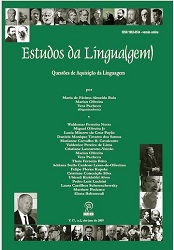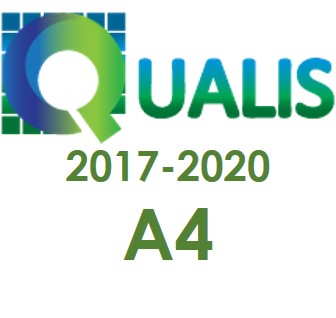Repensando los efectos de la edad en el desarrollo fónico de L2
DOI:
https://doi.org/10.22481/el.v17i2.5340Palabras clave:
: Desarrollo fónico; Segundo lengua; Periodo crítico; Input.Resumen
Una de las preocupaciones más comunes en el área de adquisición de L2 se refiere a la edad de inicio del bilingüismo / adquisición (AOA). Los estudios clásicos apuntan a una correlación negativa entre AOA y la precisión y competencia en la L2. Sin embargo, investigaciones experimentales recientes han problematizado esta hipótesis. En esta perspectiva, este trabajo, resultado de la investigación financiada por CNPq, presenta datos sobre el desarrollo de L2 por inmigrantes en contextos dominantes de L2 que contradicen la hipótesis de que el éxito del desarrollo fónico en L2 está condicionado por la maduración neurocognitiva. Los datos revelan que la variación en el input es la variable más importante en la predicción del éxito en el desarrollo de L2. El potencial de AOA como predictor de acento extranjero o éxito en L2 proviene de su asociación con la cantidad y la calidad de la información recibida por los inmigrantes /aprendientes.
Descargas
Citas
BECKNER, C. et al. Language is a complex adaptive system: position paper. Language Learning, v. 59, n. 1., p. 1-26, Dec., 2009.
BEN-RAFAEL, M.; SCHMID, M. Language attrition and ideology: Two groups of immigrants in Israel. In KOPKE, B.; SCHMID, M. S., KEIJZER, M.; DOSTER, S., (ed). Language attrition: Theoretical Perspectives, Amsterdam/Philadelphia: John Benjamins, 2007, p. 205-226.
BEST, C.; TYLER, M. Nonnative and second-language speech perception: commonalities and complemen- tarities. In: BOHN, O.; MUNRO, M.. Language Experience in Second Language Speech Learning: In honor of James Emil Flege. Amsterdam: John Benjamins, 2007. p. 13-34.
BIRDSONG, D. Interpreting age effects in second language acquisition. In. KROLL, J.; GROOT, A. (Eds). Handbook of bilingualism: Psycholinguistic perspectives. Oxford: Oxford University Press, 2005, p. 109-127.
BYBEE, J. Phonology and Language Use. Cambridge: Cambridge Univ. Press., 2001.
CHISWICK, B.; MILLER, P. (2001) A model of destination language acquisition: Application to male immigrants in Canada. Demography, 38 (3), p. 391-409, 2001.
De LEEUW, E. 2014, Maturational constraints in bilingual speech. In THOMAS E. M.;
EVANS, B.; IVERSON, P. Vowel normalization for accent: An investigation of best exemplar locations in northern and southern British English sentences, J. Acoustical Soc. America, 115, 352– 361, 2004
FLEGE, J. E. Second language speech learning: Theory, findings, and problems. In
GARDNER, R. C. Social Factors in Language Retention. In: R. D. Lambert & B. F. Freed (eds.). The Loss of Language Skills. Rowley: Newbury House, 1982, p. 24-39.
GIBSON, J. The ecological approach to visual perception. Boston: Houghton Mifflin, 1979.
HAUGEN, E. The ecology of language. In FILL, A.; MÜHLHÄUSLER. P. (Orgs.) The ecolinguistics reader (p. 57-66). London: Continuum, 2001.
HOPP, H.; SCHMID, M. S. Perceived foreign accent in L1 attrition and L2 acquisition: the impact of age of acquisition and bilingualism. Applied Psycholinguistics., 2013.
JOHNSON, J.; NEWPORT, E. Critical period effects in second language learning: The influence of maturational state on the acquisition of English as a second language. Cognitive Psychology, 21(1), p. 60–99, 1989.
KUPSKE, F.. Imigração, Atrito e Complexidade: a produção das oclusivas surdas iniciais do inglês e do português por brasileiros residentes em Londres. (Doctoral Dissertation) Universidade Federal do Rio Grande do Sul, Porto Alegre, Brazil, 2016.
______. A complex approach on integrated late bilinguals English VOT production: a study on south Brazilian immigrants in London. Ilha do Desterro, v. 70, p. 81-94, 2017.
______. Atrito de L1 por assimilação de categorias fonéticas da L2 na produção da fala de imigrantes de primeira geração. In: ATAIDE, C. A.; SOUSA, V. V.. (Org.). Língua, texto e ensino: descrições e aplicações. 1ed. Recife: Pipa Comunicação, 2018, p. 605-614.
LENNEBERG, E. Biological Foundations of Language, New York: Wiley, 1967.
MASGORET, A.; GARDNER, R. Attitudes, motivation, and second language learning: A meta-analysis of studies conducted by Gardner and Associates. Language Learning, 53(1), p. 123-163, 2003.
MCCARTHY, K.; EVANS, B.; MAHON, M. Acquiring a second language in an immigrant community: The production of Sylheti and English stops and vowels by London-Bengali speakers. Journal of Phonetics, 41, p.344–358, 2013.
MOYER, A. Ultimate attainment in L2 phonology. Studies in Second Language Acquisition, 21, 81–108. 2009.
MUÑOZ, C.; SINGLETON, D. Foreign accent in advanced learners. Two successful profiles. The EUROSLA Yearbook 7, p. 171-190, 2007.
OPITZ, C. First language Attrition and Second Language Acquisition in a Second- Language Environment. PhD dissertation, Trinity College Dublin, 2011.
SANCIER. M. L.; FOWLER, C. A. Gestural drift in a bilingual speaker of Brazilian Portuguese and English. Journal of Phonetics, 27 (4), p. 421–436, 1997.
SCHMID, M. Second Language Attrition. In BROWN, K. (Ed.). The Encyclopedia of Language and Linguistics, (Vol. 11, p. 74-81). Amsterdam: Elsevier. 2006.
______; de BOT, K. Language Attrition. In DAVIES, A.; ELDER, C. (Eds.), The Handbook of Applied Linguistics. Oxford: Blackwell Publishing, 2006, p. 210-234.
______; MEHOTCHEVA, T. H. Foreign Language Attrition. Dutch Journal of Applied Linguistics, 1 (1), p. 102-124, 2012.
______; GILBERS, S; NOTA, A. Ultimate attainment in late second: Phonetic and grammatical challenges in advanced Dutch-English bilingualism. Second language research, 30(2), p. 129-157, 2014 <DOI: 10.1177/0267658313505314>
STEVENS, G. Age at immigration and second language proficiency among foreign-born adults. Language in Society, 28, p. 555-578, 199.
______. The Age‐Length‐Onset Problem in Research on Second Language Acquisition Among Immigrants. Language Learning, 56 (4), p. 671–692, 2006
SINGLETON, D.; RYAN, L. Language Acquisition: The Age Factor. Second Edition. Clevedon: Multilingual Matters, 2004.
VAN HOUT, R.; STROMQUIST, V. The Influence of Socio-Biographical Factors. Adult Language Acquisition. Cross-linguistic perspectives. C. Perdue. Cambridge, Cambridge University Press. 1:p.164-172., 1993.
van TUBERGEN, F. Determinants of second language proficiency among refugees in the Netherlands. Social Forces, 89(2), p. 515–534, 2010.
______; WIERENGA, M. The language acquisition of male immigrants in a multilingual destination: Turks and Moroccans in Belgium. Journal of Ethnic and Migration Studies, 37(7), p. 1039–1057, 2011.
VENTUREYRA, V.; PALLIER, C., YOO, H. The loss of first language phonetic perception in adopted Koreans. Journal of Psycholinguistics, 17, p. 79–91, 2004.
YILMAZ, G.; SCHMID, M. Second Language Development in a Migrant Context: Turkish community in the Netherlands. International Journal of the Sociology of Language, 236, p. 101-132, 2015.
ZIMMER, M.; ALVES, U. A produção de aspectos fonético-fonológicos da segunda língua: instrução explícita e conexionismo. Linguagem & Ensino (UCPel), v. 9, p. 101-143, 2006.
Descargas
Publicado
Cómo citar
Número
Sección
Licencia

Estudos da Língua(gem) está bajo una Licencia Creative Commons Atribución 4.0 Internacional.
Los autores que publican en el periódico Estudios de la Lengua (g) concuerdan con los siguientes términos:
La revista Estudios del Lenguaje mantiene los derechos de autor de las contribuciones publicadas. Estos derechos incluyen la publicación de la contribución y pondrá a disposición su contenido gratuitamente a través del portal







